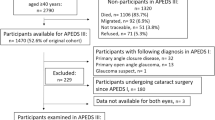Summary
Glaucoma is the third-most-frequent cause of blindness in the world, with a total of 5.2 million blind people as a result of this disease; 80 % live in developing countries. In Paraguay, after cataract it is the second-most-frequent-cause. Early detection of the risk factors and groups can help to avoid progress of this disease. Trauma, cataract and infectious uveitis represent special risks for developing secondary glaucoma, which is a more frequent cause of blindness in third-world countries than in industrialized nations. Until now there has been little data regarding the causes, disease course, and options for therapy. Therefore, secondary glaucoma was examined in Paraguay to obtain information on the situation in Latin America. The aim of the study was to explore the causes of secondary glaucoma for programs concerning prevention and therapy. From November 1996 to February 1997 patients with secondary glaucoma were examined at the University Hospital of Asunción, Paraguay. After the clinical examination the secondary glaucomas were classified. Patients with primary glaucoma were included in the same period of time as well in order to get the rate of secondary glaucoma. Altogether 293 patients were examined: 61 with secondary and 232 with primary glaucoma. The causes of secondary glaucoma in 73 eyes were: 20 (27 %) with pseudoexfoliation glaucoma, 19 (26 %) with post-traumatic glaucoma, 16 (22 %) with neovascular glaucoma, 4 (5 %) with lens-related glaucoma, 3 (4 %) with glaucoma associated with ocular surgery, 2 (3 %) with pigmentary and 2 (3 %) with corticoid-induced glaucoma. A ratio of 4:1 primary glaucomas to secondary glaucomas was found. The development of special measures for prevention and early therapy is only possible if the causes of this severe disease are explored. The results of this study represent basic information and could help to introduce of prevention programs.
Zusammenfassung
Hintergrund: In Entwicklungsländern ist das Sekundärglaukom eine häufigere Erblindungsursache als in Industrienationen. Insbesondere zählen Trauma, Katarakt und die infektionsbedingte Uveitis zu den Risikofaktoren. Bisher liegen wenig Daten über Ursachen und Verlauf sowie Therapieansätze vor.
Patienten und Methode: In Paraguay wurden die Ursachen des Sekundärglaukoms untersucht, mit dem Ziel, eine Basis für präventive sowie therapeutische Maßnahmen zu schaffen. Bei den Patienten mit Sekundärglaukom wurde eine Anamnese und eine klinische Untersuchung durchgeführt.
Ergebnisse: 8 verschiedene Sekundärglaukomformen konnten diagnostiziert werden, wobei sich 3 Hauptursachen herauskristallisierten: das Pseudoexfoliationsglaukom, das posttraumatische Glaukom und das Neovaskularisationsglaukom.
Schlußfolgerung: Anhand dieser Ergebnisse werden die Risikogruppen und zugrundliegenden Erkrankungen des Sekundärglaukoms in Paraguay aufgezeigt und stellen eine Orientierung für die Entwicklung und den frühzeitigen Einsatz von Präventivprogrammen dar.
Similar content being viewed by others
Author information
Authors and Affiliations
Rights and permissions
About this article
Cite this article
Strohl, A., Pozzi, S., Wattiez, R. et al. Causes of secondary glaucoma in Paraguay. Ophthalmologe 96, 359–363 (1999). https://doi.org/10.1007/s003470050418
Published:
Issue Date:
DOI: https://doi.org/10.1007/s003470050418




